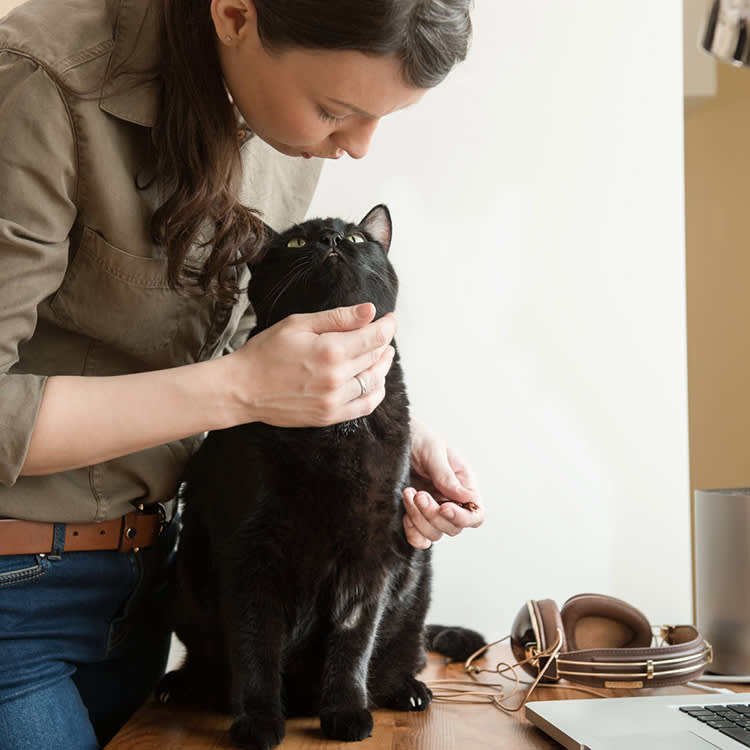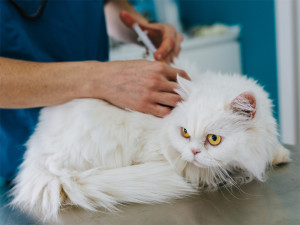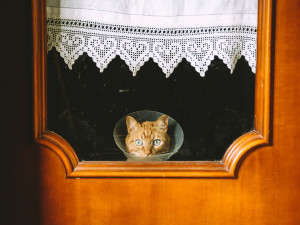How to Give a Cat a Pill
Everything you need to know about the difficult task of medicating a cat.

share article
It’s not easy to give medication to a cat. In fact, it’s arguably one of the hardest parts of having a cat, and the stories people tell about their attempts are high drama for sure. Cats are not naturally agreeable about taking their medication, especially in pill form. It’s up to us to help them to help themselves by making it as easy as possible for them to do what they need to do.
How to give a cat a pill
The goal is to make the experience as positive as possible, for us — and for them. That means teaching them how to take medication rather than forcing them to do so. That lessens everyone’s stress and means you can avoid being scratched or bitten. This can happen when people try to force cats to take their pills.
What to consider before giving your cat medication
Before giving your cat medication, prepare to do so. By preparing, I don’t mean laying out all the supplies a few minutes ahead of time or putting on a thick coat to protect your skin from the teeth and claws of a distressed cat. When I say “prepare,” I mean train your cat to take medication long before your cat is in need of it.
Part of our training of our cats should be teaching them the skills they need to participate in their own care, including taking pills when necessary. You can’t train a cat to take medication starting when you get home from the veterinarian with the medicine you need to give that day. Cramming for the test with this kind of training is ineffective, so you have to start when you welcome your cat into your family.
What are the common ways to administer medicine to my cat?
A lot of the common ways to administer medication to cats involve forcing them. If you search on YouTube for “how to give a cat a pill,” “how to get a cat to take a pill,” “how to give a cat a pill with a syringe”, “how to give a cat a pill by hand”, “how to use a pill popper to medicate a cat” or similar phrases, you will be treated to a series of videos of distressed cats having pills physically forced into their mouths and throats.
Some give a nod to being positive by saying to give them a treat afterwards with promises that they will then forget all about it. It is false and frankly absurd to assert that a traumatized cat will forget a bad experience after being given a treat. Come on, would you forget something traumatic just because someone gave you a cupcake at the same time? All of these methods share a common set of steps.
Hold the cat facing away from you with their back against you so they can’t back up. If the cat is “difficult” or likely to resist, have another person help restrain the cat.
Protect yourself from bites and scratches by wearing gloves, wrapping the cat in a blanket, and holding the cat’s front shoulders to prevent them from moving.
Pry open the cat’s mouth.
Put the pill into the cat’s mouth on the back of their tongue.
Close the cat’s mouth and stroke the throat to encourage swallowing.
If you do get bitten by the cat, seek medical care as cat bites easily become infected.
These forceful methods that put the cat in the position of pilling happening to them rather than offering the opportunity to participate willingly in their own care are not the best plan. They are likely to upset most cats and make it even harder to get the next dose in, and there is a serious risk of injury to the people forcing the cat. There are better ways to give medication to a cat that won’t be distressing for the cat, dangerous for you, or harmful to the relationship between you.
How to give your cat a pill: stress-free methods
If your cat is willing to take the medicine, then there is no need to make a big production out of it. You just offer your cat the medicine, they take it, and you continue with your day. Sounds amazing, right? This is possible with some cats (though honestly, not all take to it as easily as we might like.) These stress-free methods of giving cats their medicine are wonderful options to try.
Make the medicine palatable.
Ask your veterinarian if the medicine can be put into a palatable form. Some medicines can be compounded into a yummy liquid, often with fish flavor. Many cats will happily take medicine in this form from a syringe. Another option with some medicines is mixing the medicine into a tasty, chewable tablet. More cats are suspicious of this than the liquid, but if it works for your cat, it makes everybody’s life easier.
Give the medicine with wet food.
Wet food can hide pills enough for many cats to ingest them. To be fair, some cats will eat around the pill even if it is within tuna or something equally delicious, but the better the food, the more likely the cat will scarf the pill down with it. Cover the pill with some wet food and serve it to your cat along with additional wet food. Sometimes feed your cat this wet food in the same manner without a pill so they don’t get wise to you. Easy cheese is another food that can be used to give pills like this.
Use pill pockets.
Pill pockets are tasty treats with a hollow area that can hold a pill. They are similar in consistency to play-doh so you can put a pill in and shape the treat around it and cover the pill completely. Some cats happily take these, and it’s best to try them empty to see if your cat likes them before trying them with a pill. To keep a cat eating these whenever needed, sometimes give them one with no pill in it.
Wrap in treats.
You can use any soft treat that’s big enough and mold it into your own pill pocket, but always give your cat empty ones before trying it with a pill, and continue to give empty ones sometimes even once you are using them for pills.
One strategy that works well for many cats is to give them three treats in a row and vary which one contains the pill. Start with the middle one containing the pill so the cat gets a pill-free one, then the pill, then a treat as a chaser. The ultimate treat for many cats is freeze-dried minnows which can be sliced open at the belly to insert a treat. Sometimes give them three treats in a row without any of them containing a pill.
Use gel capsules.
Put the pill inside a gel capsule, using the smallest one that will hold the pill. Coat the gel capsule in something delicious, such as liquid from a can of tuna, real salmon, wet cat food, or pureed chicken. Teach your cat to eat empty gel capsules coated in something appetizing before you try this with a pill, and sometimes give them an empty one just to keep them happy about the process.
Train your cat to take a pill.
The common question, “How to get a cat to take a pill?” should be transformed to a less coercive one that reads, “How to train a cat to take a pill?” No matter what method you choose to use, the basic plan is the same — make taking a pill a positive experience for your cat. Teach them the skill of taking medication in pill form (or in a liquid or chew if possible) before they ever need to take medication.
When there is no pressure to get a dose of medication in your cat, and they are as relaxed as possible, it’s easier to teach this skill. Give them blanks, whether that is a pill pocket, a gel capsule, a blog of wet food, or some tasty puree or liquid in a syringe. Do this a few times a week, so it becomes a regular and pleasant part of their life. Then, when the time comes that they need to take a pill, do just what you have done all those times but with the addition of the pill. Whether they need pills for a short period of time or as a lifelong form of care, continue to give them the pills as needed and give them blanks to keep them from rejecting the pills.
Don’t force your cat.
It can’t be said too often — forcing your cat to take pills can be traumatic for them, dangerous for you, and damaging to your relationship. Yes, it is essential for your cat’s health to get them to take their medicine, but try not to damage their mental health in the name of their physical health.
Safety tips for giving a cat pills
The best safety tip for giving a cat a pill is to teach them how to take pills so they are not fighting you while you try to take care of their health. Cats who scratch and bite when being given a pill are cats who are unhappy about the situation. Your best protection is to train your cat to take a pill so they are not fighting you when they need to be medicated.
What if my cat refuses to take a pill?
If you find your cat unwilling and unable to take a pill, remember to be patient and try different methods. Keep hope alive that you will be able to get the medicine to go down with a method that is not upsetting to anyone. If you still have no luck, let your vet know. They need to know if your cat misses a dose so they can advise you about any medical consequences related to that.
To avoid injury to yourself and damage to your relationship with your cat, you can have someone else administer the medication. The aversiveness of the situation will not transfer to you and you can continue to work on training your cat to take a pill. Most veterinary practices can help you with this for a fee, so this may be a viable option if the medication is not something that must be given long term.
Consider going to a different veterinary office than your usual one so your cat does not associate the experience with visits to their regular vet. If you are the one to force your cat, it will set back the training process. As a last resort, if you must do whatever you need to do to get your cat to take the pill because the medical costs of not doing so are too high, go to a totally different location than the area you are using to train your cat to minimize the negative effects on the training.
References

Karen B. London, PhD, CAAB, CPDT-KA
Karen B. London, Ph.D., is a Certified Applied Animal Behaviorist and Certified Professional Dog Trainer who specializes in working with dogs with serious behavioral issues, including aggression, and has also trained other animals including cats, birds, snakes, and insects. She writes the animal column for the Arizona Daily Sun and is an Adjunct Professor in the Department of Biological Sciences at Northern Arizona University. She is the author of six books about training and behavior, including her most recent, Treat Everyone Like a Dog: How a Dog Trainer’s World View Can Improve Your Lifeopens in a new tab.
Related articles
![a cat making a strange face with its mouth open.]() opens in a new tab
opens in a new tabIs Your Cat Judging You?
That disapproving sneer is actually the “Flehmen response.” A cat behaviorist explains how to read cats’ lips.
![kitten lying on the floor breathing through his mouth]() opens in a new tab
opens in a new tabIs My Cat...Panting?
“Cats don’t pant to cool off like dogs do.” Unless your pet is catching their breath after doing the zoomies, Dr. Gary Weitzman says it could be cause for concern.
![A cat getting its ear cleaned.]() opens in a new tab
opens in a new tabCat First Aid 101
From performing CPR to preventing shock, three vets break down everything you need to know to help your cat in an emergency.
![French bulldog puppy looking scared at vet]() opens in a new tab
opens in a new tab10 Things to Ask at Your First Vet Visit
There are no stupid questions — well, when it comes to your dog’s health.
![Brown Labrador lifting front leg]() opens in a new tab
opens in a new tabHow to Get a Head Start on Your Pet’s Health
Spot lumps, limps, and lethargy early on.
![cat getting a vaccine at the vet]() opens in a new tab
opens in a new tabYep, Kittens Need Vaccines (Even Indoor Ones)
A vet gets the facts straight.











